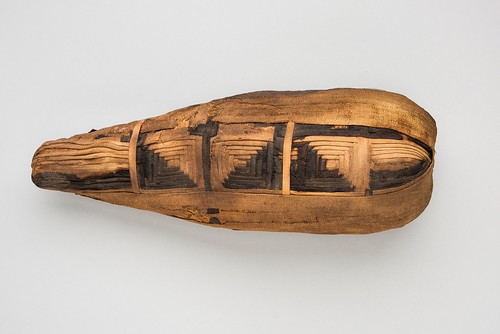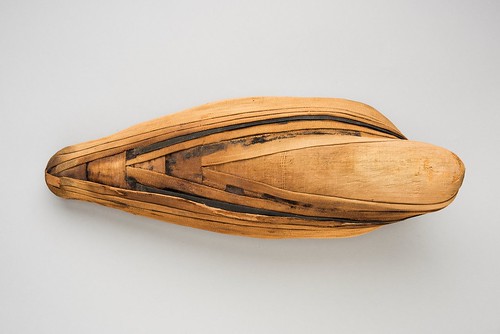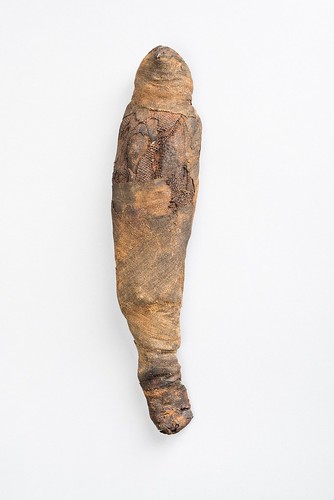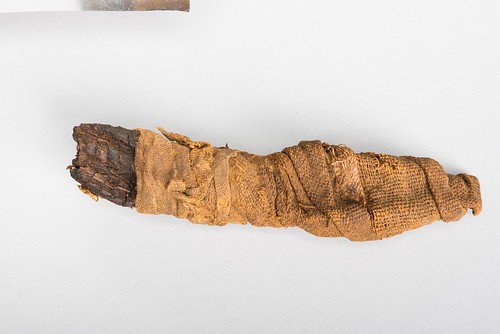When you think of a mummy, you probably think of Egypt. Or maybe you think of the Hollywood movie The Mummy, starring Brendon Fraser. But what if you were to discover that there are actual mummified animals laid to rest alongside their ancient Egyptian masters?

That exciting discovery is the factual premise of Egyptian Animal Mummies: Science Explores an Ancient Religion exhibition on display through July 1, 2018, at the San Antonio Museum of Art. The exhibit, situated on the fourth floor exhibition gallery, is free with general museum admission.
The exhibit, featuring three mummified crocodiles, three falcons, two ibises and a cat, is being paired with the museum’s bronze reliquaries ancient Egyptian Collection for the first time.

And anyone visiting San Antonio, Texas on Sunday, May 6, is in luck. That’s “Family Day” at the museum. A special program “See & Do: Hello Mummy” will be held from 1 to 4 pm for children 12 and under for free.
The daily life of an Egyptian required an intimate relationship with a specific deity or god. For example, the ibis was sacred to Thoth, the god of wisdom. Consequently, an Egyptian would honor the animal. This ideology of reverence toward such animals as cats, crocodiles and ibises, is illustrated in this exhibition.
“The Egyptians believed that animals possessed qualities that were human in nature as well as mysterious. They associated animals with the divine realm,” said Susan Schellinger, Ph.D. and exhibit curator.
“Given that the Egyptian’s relationship with the gods and goddesses was an integral part of their daily lives, this exhibition provides essential insight into that ideology,” said Schellinger, SAMU ‘s Andrew W. Mellon Postdoctoral Curatorial Fellow.

Another unique aspect of this exhibition, part of a yearlong celebration of the city’s 300th birthday, is that it’s a collaborative effort with the San Antonio Zoo and the University of Texas at San Antonio Health’s Radiology Department.
Thanks to modern science in the form of X-ray imaging and CT scanning, experts were able to analyze the animal mummies without unwrapping them. The medical exams and the results will be available to exhibition visitors.

“Not everyone knows there was a practice of mummifying animals. But in fact, the practice was so popular that some of the animals became scarce, which led to the creation of fake mummies,” said Schellinger.
Ancient Egyptians had a whole host of reasons they might want to mummify an animal. Since they believed in the “afterlife,” Egyptians might mummify a beloved pet so that it would accompany its master even after his or her death. Some animals were also buried so that the dead would have food.
The nearly 10 animal mummies on display at SAMA are classified as “votive mummies,” raised by temple priests who then mummified them as offerings to the deities. Sobek, the god of fertility and rebirth considered the crocodile sacred and Bastet, the goddess of protection considered the cat sacred.

Since the exhibition’s opening in March, the museum has held a series of dynamic educational lecture programs aimed at informing and teaching the public about ancient Egyptian religious customs.
In fact, from 6 to 8 pm on Friday, June 8, museum visitors may enjoy the “Cats, Crocodiles, and Raptors Art Party,” which is free and open to the public with general museum admission tickets.
The highlight of the lecture series featured Salima Ikram, Ph.D., distinguished professor of Egyptology at the American University in Cairo. Dr. Ikram is the world’s leading expert on animal mummification.

Egyptian Animal Mummies: Science Explores an Ancient Religion is made possible by the generous support of the Andrew W. Mellon Foundation, Egypt’s American Research Center, Sarah E. Hart and John S. Gutzler Fund of the San Antonio Are Foundation and several other organizations and individuals.
The San Antonio Museum of Art contains nearly 30,000 works representing 5,000 years of history. SAMA is situated on the city’s popular Museum Reach and housed in the repurposed historic Lone Star Brewery. The centrally located museum is the nerve center for events, tours, lectures, symposiums and celebrations.
The SAMA is at 200 W. Jones in San Antonio. Museum hours are from 10 am to 9 pm Tuesday through Friday, 10 am to 5 pm Wednesday, Thursday, Saturday and Sunday. The museum is closed on Mondays. For more information go to www.samuseum.org or call (210) 978-8100.
Rosie Carbo is the Lifestyles Editor for Wandering Educators, and is a former newspaper reporter whose work has appeared in newspapers and magazines nationwide. Some of those publications include People magazine, The Dallas Morning News, The Houston Chronicle, and San Antonio Express-News. Some of her features were redistributed by The Associated Press early in her career as an award-winning Texas journalist.
Photos used with permission. Credits:
Falcon Mummy with Lidded Mummy Jar
Egyptian (Late Period -Roman Period), ca. 712 BC – AD 395
Falcon remains and linen and terracotta, mummy: h. 9 ¾ in. (24.8 cm); w. 3 in. (7.6 cm) / jar: h. 15 ½ in. (39.4 cm)
San Antonio Museum of Art, gift of Beryl and Hank McCleary, 2003.50.1.1-2
Photography by Peggy Tenison
Crocodile Mummy
Egyptian (Late Period -Roman Period), ca. 712 BC – AD 395
crocodile remains and linen, l. 12 in. (30.5 cm)
San Antonio Museum of Art, gift of Gilbert M. Denman, Jr., 91.80.110.b,d
Photography by Peggy Tenison
Ibis Mummy
Egyptian (Late Period -Roman Period), ca. 712 BC – AD 395
Ibis remains and linen, h. 3 ½ in. (8.9 cm); l. 13 in. (33cm)
San Antonio Museum of Art, bequest of Gilbert M. Denman, Jr., 2005.1.37
Photography by Peggy Tenison
